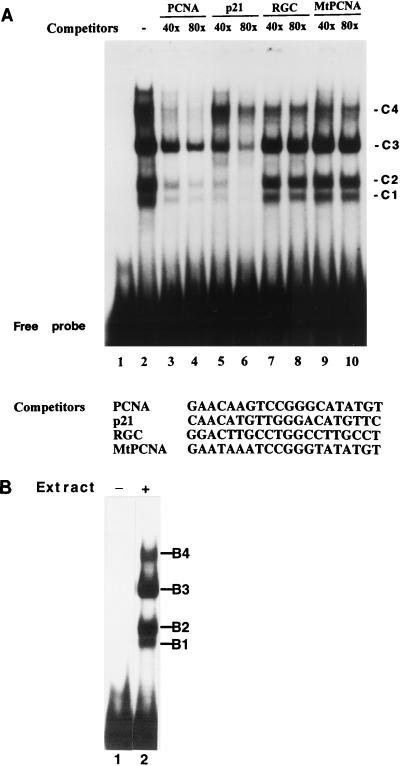FIG. 5.
Binding specificity of complexes formed in EMSAs with nuclear extracts prepared from irradiated CREF cells. (A) Binding to the PCNA p53 binding site. A double-stranded oligonucleotide corresponding to the PCNA p53 binding site (PCNA) was used as the radiolabeled probe. Double-stranded oligonucleotides corresponding to the p53 binding site in the WAF1 gene (p21), the ribosomal gene cluster (RGC), or a mutated version of the PCNA site (MtPCNA) that fails to bind p53 (70) were used as unlabeled competitors in the EMSA. Lanes 1 and 2 show the radiolabeled probe without extract and with extract prepared from CREF cells 3 h postirradiation, respectively. Experimental conditions for lanes 3 to 10 were identical to those for lane 2 except that the indicated competitors were included in the binding mix at either 40- or 80-fold excess compared to labeled probe. The four specific complexes that form in the assay are designated C1 to C4. The gel was overexposed (more than 48 h) to reveal the oligonucleotide competition for all four complexes. The detection of the relatively minor C4 complex varied between experiments. (B) Binding to the p53 binding site of the WAF1 gene. Details are as for panel A except that a double-stranded oligonucleotide corresponding to the p21WAF1 p53 binding site was used as the radiolabeled probe. Complexes B1 through B4 comigrate with complexes C1 through C4 formed with the PCNA probe in panel A (not shown). Lane 1, WAF1 probe without extract; lane 2, WAF1 probe with nuclear extract prepared from CREF cells at 3 h postirradiation.

